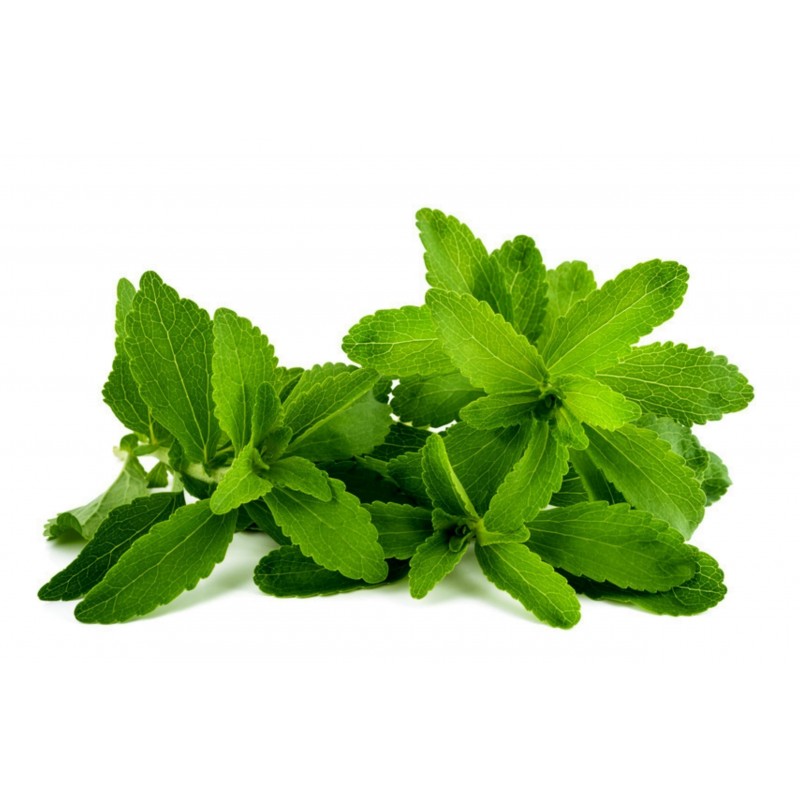
Stevia Seeds (Stevia rebaudiana)
Stevia Seeds - Herb
Price for Package of +-100 (0,06 g) seeds.
Stevia is a genus of about 240 species of herbs and shrubs in the sunflower family (Asteraceae), native to subtropical and tropical regions from western North America to South America. The species Stevia
Stevia Seeds - Herb
Price for Package of +-100 (0,06 g) seeds.
History and use
In 1899, the Swiss botanist Moisés Santiago Bertoni, during his research in eastern Paraguay first described the plant and the sweet taste in detail.[11] Only limited research was conducted on the topic until, in 1931, two French chemists isolated the glycosides that give stevia its sweet taste.[12] These compounds were named stevioside and rebaudioside, and are 250–300 times as sweet as sucrose, heat stable, pH stable, and non-fermentable.
Today, stevia is cultivated and used in food elsewhere in east Asia, including in China (since 1984), Korea, Taiwan, Thailand, and Malaysia. It can also be found in Saint Kitts and Nevis, in parts of South America (Brazil, Colombia, Peru, Paraguay, and Uruguay), and in Israel. China is the world's largest exporter of stevioside.
Folk medicine and research
Sowing Instructions | |
| Propagation: | |
| Pretreat: | 0 |
| Stratification: | 0 |
| Sowing Time: | all year round |
| Sowing Depth: | Needs Light to germinate! Just sprinkle on the surface of the substrate + gently press |
| Sowing Mix: | Coir or sowing mix + sand or perlite |
| Germination temperature: | min. 21 ° C |
| Location: | bright + keep constantly moist not wet |
| Germination Time: | 1-2 weeks |
| Watering: | Water regularly during the growing season |
|
|
|
| بذور العضوية؟ | Organic Seeds |
|---|---|
| العضوية / الطبيعية؟ | Organic/Natural: Yes |
| صالح للأكل؟ | Edible |
| نبات معمر؟ | Perennial plant : Yes |
| بذور منتقاة بعناية؟ | Handpicked seeds |
| النبات مناسب للنمو؟ | The plant is suitable for growing in a greenhouse The plant is suitable for growing on a balcony-terrace The plant is suitable for outdoors cultivation |
| مناسبة للنمو في وعاء الزهور؟ | Suitable for pot: Yes |
| نبات طبي ؟ | Medicinal Plant: Yes |
| البذور تتطلب الضوء للإنبات؟ | Requires light for germination |


Your review appreciation cannot be sent
Report comment
Report sent
Your report cannot be sent
اكتب تعليقك
Review sent
Your review cannot be sent
🌍 الشحن العالمي من الاتحاد الأوروبي
نقوم بالشحن إلى جميع أنحاء العالم من الاتحاد الأوروبي باستخدام بريد مسجل مع تأكيد استلام.
📦 تتبع الشحنة
لتتبع شحنتك، قم بتسجيل الدخول إلى حسابك، ثم اذهب إلى سجل الطلبات > التفاصيل وستجد رقم التتبع هناك.
التتبع العالمي: 17Track
لتتبع أرقام مثل RGxxxxxxHR: تتبع Posta.hr
🕒 يرجى الانتظار 24 ساعة على الأقل بعد الشحن لظهور معلومات التتبع.
⚠️ ملاحظات هامة
الدفع عند الاستلام غير متاح.
تحقق من مجلد البريد العشوائي/الغير هام في بريدك الإلكتروني للحصول على إشعارات الطلبات.
استخدم فقط نموذج الاتصال الموجود على موقعنا.
لن يتم الرد على الرسائل المرسلة مباشرة إلى بريدنا الإلكتروني.
📱 رقم الهاتف مطلوب
يرجى إدخال رقم هاتفك المحمول مع رمز البلد.
مثال: +966 512 345 678
🚚 شروط التوصيل
تتطلب الشحنات المسجلة توقيع المستلم.
لا تطلب إذا:
كنت تريد التسليم إلى صندوق بريد
لن تكون متواجداً لاستلام الطرد
تريد تسليمه إلى جار (❌ هذا غير ممكن)
📬 إذا أدخلت عنوان صندوق بريد وفُقدت الشحنة، فلن تكون مؤهلاً لاسترداد الأموال.
↩️ المرتجعات وإعادة الشحن
إذا تم إرجاع الشحنة إلينا لأي سبب:
سيتم فرض رسوم إرجاع 2 يورو
بالإضافة إلى تكلفة إعادة الشحن
⏱ التأخير والتتبع
إذا أظهر التتبع أن الشحنة لا تزال عند المرسل، فهذا يعني أنها في الطريق.
يرجى التواصل مع مكتب البريد المحلي باستخدام رقم التتبع.
نحن لسنا شركة بريدية ولا يمكننا تتبع الشحنات بالنيابة عنك.
لسنا مسؤولين عن مدة التوصيل.
🔍 يمكننا بدء تحقيق بفقدان الشحنة بعد مرور 30 يوماً على تاريخ الشحن فقط.
✈️ خيارات الشحن
| نوع الشحن | وقت المعالجة | تأمين | احتمال التأخير | ملاحظات |
|---|---|---|---|---|
| الشحن العادي | 7–10 أيام عمل | ❌ | 7–14 يومًا | الخيار الاقتصادي |
| شحن ذو أولوية | 1–7 أيام عمل | ❌ | 3–10 أيام | أولوية في المعالجة – لكن ليس بالضرورة أسرع شحن |
| شحن مؤمَّن | 1–7 أيام عمل | ✅ | 3–10 أيام | استرداد في حال فقدان الشحنة، متاح للطلبات حتى 150 يورو |
🕒 المدة التقديرية للتوصيل:
داخل الاتحاد الأوروبي: 3–20 يوم عمل
عالميًا: 5–30 يوم عمل
أمثلة للتوصيل إلى الولايات المتحدة: 27، 22، 19، 17، 13 يومًا
💳 طرق الدفع
💶 التحويل البنكي (SEPA / IBAN / SWIFT-BIC)
تأكد من كتابة رقم الطلب في تفاصيل التحويل (مثال: SGS-19811702).
في حال غياب المرجع، قد يتأخر تأكيد الدفع أو يتم إلغاء الطلب.
إذا لم يتم استلام الدفعة خلال 7 أيام، سيتم إلغاء الطلب تلقائيًا.
🅿️ PayPal
نقبل المدفوعات بـ اليورو فقط عبر PayPal.
يرجى تحويل العملة إلى اليورو أثناء عملية الدفع.
💳 الدفع بالبطاقة
الدفع يتم عبر موقعنا: Exotic Seeds Store
نقبل: Visa، MasterCard، American Express، Diners Club، UnionPay، JCB، Discover وغيرها.
💡 العميل يتحمل رسوم المعاملات البنكية إن وجدت.
يرجى تزويدنا بإثبات الدفع لتسريع معالجة طلبك.
📅 ملاحظات إضافية
لا نعالج الطلبات أو نقوم بالشحن أيام السبت والأحد.
يرجى دائمًا قراءة التنبيهات الهامة على موقعنا (مثل العطل الرسمية أو الشروط الخاصة).
📫 ملاحظة:
لا ترسل لنا رسائل على البريد الإلكتروني مباشرة. استخدم فقط نموذج الاتصال الموجود على موقعنا.
Related Products











